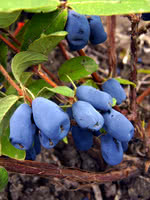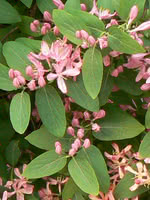Mon-Fri 9am - 5pm Mountain time
Tundra Haskap (Honeyberry) vs Twining Honeysuckle
Lonicera caerulea Tundra
Lonicera dioica
CUSTOM GROW
Tundra Haskap is sweet/tangy with a great flavour. The flavour of Haskaps is generally described as a cross between a blueberry and a raspberry. Tundra Haskaps are well suited to fresh eating, freezing, baking, and preserves. They have the firmest berries, which makes them well-suited for commercial production
For optimal fruit production, cross-pollination is required. Haskaps need to be planted with a compatible variety. Compatibility is influenced by both bloom time and genetics.
Tundra Haskap is an early-pollinating variety and pairs well with Aurora and Honey Bee.
Twining Honeysuckle is a vine native to the forests of Canada and the United States.
It can often be found winding up the bark of large trees or spreading out as a ground cover where no supports are present. You will love the attractive, yellow-orange flowers with pink centers which turn into red, inedible berries.
Consider Twining Honeysuckle when trying to achieve a natural, spreading, unkempt look for your garden.

